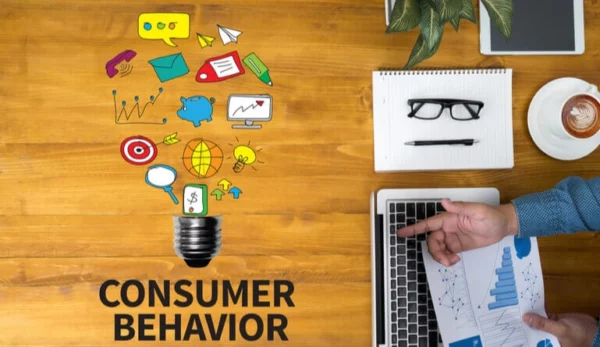How Has Digital Marketing Affected Consumer Behavior?

How Has Digital Marketing Affected Consumer Behavior?
Digital marketing has undoubtedly pushed marketers all around the world to change the way they approach marketing. Not only that, but the evolution of marketing tools has affected how consumers behave and make decisions.
Digital marketing is the area of marketing that promotes goods and services using the Internet and other online-based digital technology like desktop and mobile computers and other digital media and platforms. The way brands and companies use technology for marketing has altered as a result of its development in the 1990s and 2000s.
Digital marketing campaigns have increased as a result of the integration of digital platforms into marketing strategies and daily life and the rise in the use of digital devices by consumers in place of physical stores. These campaigns often combine search engine optimisation (SEO), search engine marketing (SEM), content marketing, influencer marketing, content automation, campaign marketing, data-driven marketing, e-commerce marketing, social media marketing, and social media advertising.
The term “digital marketing” encompasses non-Internet platforms that offer digital media, like television, mobile phones (SMS and MMS), callback, and on-hold ringtones. Digital marketing is distinct from online advertising due to its expansion into non-Internet platforms.

What is Consumer Behaviour?
Consumer behaviour primarily refers to the buying habits and decision-making processes of consumers. These are people that are searching for goods and services for their own use.
Businesses all throughout the world value information on consumer behaviour. This is a result of their ongoing efforts to improve both the shopping experience and, ultimately, their sales numbers.
They can comprehend consumer expectations in the market by studying consumer behaviour. Additionally, it helps them to make adjustments that will allow customers to make wiser purchasing choices.
Information on what customers buy, where they buy it, and when they believe it is included in the study. Additionally, it displays details about their intentions, purchasing patterns, and other things.
What does History tell us about Changing Consumer Behavior?
Every discovery and technological advancement in human history has improved society.
Even though people have been using printing for at least 5,000 years, Johannes Gutenberg’s development of the printing press in the 1500s marked a permanent shift in consumer behaviour. Manufacturers were given the ability to reach thousands of individuals through the modest newspaper. Newspaper advertisements were used by manufacturers of the time to sway and alter consumer behaviour. Newspapers’ success is further demonstrated by the fact that they continue to alter consumer behaviour to this day.
The same thing happened when commercial radio first appeared in the 1910s and 1920s. Despite being a government monopoly at the time, radio stations found businesses willing to pay for the right to broadcast their commercials.
Similar holds true for TV and movies, which completely changed the way we influence consumers. Consumer behaviour was significantly influenced by watching movie stars and other famous people utilising or doing certain actions.
And in the modern-day, digital marketing—previously known as Internet marketing—does the same thing. However, unlike anything previously observed through newspapers, radio, TV, and movies, internet marketing is altering consumer behaviour. Or even offline media like hoardings and displays that are placed along roadsides.
Here are some ways digital marketing has impacted and still influences customer behaviour in light of the global spread of the Internet and the easier availability of relatively inexpensive web-accessible gadgets.
Impact of Digital Marketing and Ecommerce on Consumer Behavior
Look at your spending and purchasing habits as a consumer. You’ll undoubtedly see a big difference between these and the last 20 years when digital marketing was starting to take off. Several relevant examples of how digital marketing has altered customer behaviour are provided below:

Access to global marketplaces
Digital marketing has provided consumers access to products from markets around the world unless importing goods is prohibited in your nation. With just a mouse click or a touch of your smartphone screen, it’s now simple to buy practically anything from any country or continent. VPN services may even help you to access geo-restricted content when it is inaccessible in your area.
As a result, more consumers are choosing expensive or uncommon imported goods that weren’t previously widely accessible. So people now desire imported goods and, in many cases, the sophisticated tastes that come with spending a lot of money on items from elsewhere.

Real-time research into products
When we examine how consumers conduct product research before purchasing, we may see another major shift in consumer behaviour. Increasing numbers of people now conduct online research into the benefits and drawbacks of everything through blogs, reviews on eCommerce portals, manufacturer websites, and social media, regardless of whether it’s a cheap bar of soap or an expensive electronic device. Not even thirty years ago did people engage in this behaviour.
At least 80% of consumers read blogs and product evaluations during the initial stage of their purchasing process, according to studies and research conducted by digital marketing companies. Simple decision-making while obtaining the most value for money is the aim of this type of research.
Therefore, no manufacturer can afford to ignore the impact of digital marketing on consumers. They know that a product won’t do well in the market if it receives bad or unfavourable reviews. In order to sway consumer behaviour by tipping the scales in their favour, they create products that will unavoidably receive positive and favourable ratings.

Shopping baskets anywhere, anytime
Customers now have the opportunity to use internet shopping to purchase a variety of goods from multiple suppliers, thanks to digital marketing. They have dozens of online stores where you can use coupons to get anything you want for less money or with significant discounts. As a result, there is less steadfast devotion to a particular brand or retailer.
A consumer is well-informed about available options and costs thanks to email marketing, Facebook posts, tweets on Twitter, Instagram, and Pinterest ads, and pop-up adverts on the Internet. Such targeted adverts that are based on a user’s browsing history are abundant thanks to Google AdSense.
There are so many online retailers to choose from that both buyers and sellers are spoiled for choice. Sincere and great reviews from affiliate marketers, who are primarily bloggers and digital marketers, influence consumers and direct them to make immediate purchases through affiliate links.
The Facebook Marketplace, Facebook pages, and online marketplaces like Etsy and Shopify are being used by retailers and artisans of all stripes to sell their goods concurrently. As a result, a customer has access to many channels for making the same purchase.

Discount mindset grows
Consumers used to search for bargains in the past. Online retailers are in a race to give discounts on practically every product due to digital marketing courses and rising awareness of cheaper goods accessible elsewhere. For example, stores like Walmart, Target, and Giant, to mention a few, advertise discounts on particular days for particular products or give printed or online coupons.
Every price listed online already includes a tiny reduction, as shoppers on Amazon, eBay, and other websites will discover. In the past, a customer would have to bargain with business owners or salespeople to get a few dollars off the sticker price. Compare this situation to those earlier.

FOMO through email marketing
Consumers may stay updated and connected with their preferred suppliers even when they are travelling abroad, thanks to email marketing, a crucial component of digital marketing. They can learn about things like new releases and price reductions without physically going to a store. They discover that such material is instead readily sent to their email.
Customers no longer have to worry about missing an offer, a deal, or a new release. They can immediately place orders as an alternative. Customers can easily purchase by clicking on an interactive link provided through email marketing.

Customer loyalty is rare
To keep customers’ loyalty, the majority of online retailers give large discounts and freebies. It is more challenging than ever for any offline, brick-and-mortar business to develop a devoted consumer base. Because of this, merchants offer loyalty points for each dollar that customers spend. These points can be redeemed for cash when paying bills for upcoming purchases. Then there are offers for cashback.
Amazon Prime is one such traditional illustration of a loyalty programme. Customers may access a number of services through Amazon Prime for a nominal annual fee, including free and speedier shipping, priority service when purchasing certain items, free music and movies, and much more. Consumer behaviour has changed as a result. All consumers desire value adds in addition to their purchases.

Credit and monthly instalments support purchases
The purchase habits themselves are a key component of digital marketing and influence customer behaviour. Prior to the invention of credit cards, customers could not make purchases on credit or enjoy the luxury of deferring payment. This situation has been permanently altered by digital marketing.
Retailers are compelled to make purchasing easier by providing Equal Monthly Instalments (EMIs) and other amenities due to the drive to please customers online. In rare cases, merchants provide EMI plans and interest-free credit. These persuade customers to make an expensive purchase right away rather than delaying it.

Surveys and pennies for every thought
Any person might be asked if they would have invested time in searching for and completing internet surveys a few years ago. The response would have undoubtedly been a resounding “no.”
All consumer companies are now engaged in fierce competition to outdo one another by developing and releasing cutting-edge items and utilising marketing technology due to digital marketing. Customer feedback is necessary for this. As a result, they have consumer-focused online surveys made using quiz software. Because market research firms reward their efforts with money or free shopping coupons from leading brands, consumers are more than happy to take part in online surveys or write product reviews.
 Conclusion: Expect more changes
Conclusion: Expect more changes
Here are just a few examples of how digital marketing has changed how consumers view brands. Customers will have more control over their purchasing experience as more sophisticated technology emerges. However, businesses may influence their potential customers purchasing behaviours thanks to the same constant advancement in technology. It will be fascinating to see how digital marketing will influence how people will shop in the future.
Edited by Prakriti Arora




